
The Romulans are an extraterrestrial race in the American science fiction franchise Star Trek. Their adopted home world is Romulus, and within the same star system they have settled a sister planet Remus. Their original home world, Vulcan, was renamed Ni'Var later in canon. They first appeared in the series Star Trek (1966–1969). They have appeared in most subsequent Star Trek releases, including The Animated Series, The Next Generation, Deep Space Nine, Voyager, Enterprise, Discovery, Picard, Strange New Worlds, and Lower Decks. They appear in the Star Trek feature films Star Trek V: The Final Frontier (1989), Star Trek VI: The Undiscovered Country (1991), Star Trek: Nemesis (2002) and Star Trek (2009). They also appear in various other spin-off media, including books, comics, toys and games.

Vulcans, sometimes referred to as Vulcanians, are a fictional extraterrestrial humanoid species in the Star Trek media franchise. They are noted for their strict adherence to logic and reason and suppression of emotion. Known for their pronounced eyebrows and pointed ears, they originate from the fictional planet Vulcan. In the Star Trek universe, they were the first extraterrestrial species to make contact with humans.

Spock is a fictional character in the Star Trek media franchise. He first appeared in the original Star Trek series serving aboard the starship USS Enterprise as science officer and first officer and later as commanding officer of the vessel. Spock's mixed human–Vulcan heritage serves as an important plot element in many of the character's appearances. Along with Captain James T. Kirk and Dr. Leonard "Bones" McCoy, he is one of the three central characters in the original Star Trek series and its films. After retiring from active duty in Starfleet, Spock served as a Federation ambassador, and later became involved in the ill-fated attempt to save Romulus from a supernova, leading him to live out the rest of his life in a parallel universe.

Jonathan Archer is a fictional character in the Star Trek franchise. He is one of the protagonists of the television series Star Trek: Enterprise, where he was portrayed by Scott Bakula.
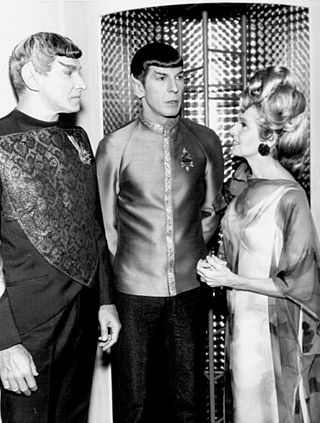
Sarek is a fictional character in the Star Trek media franchise. He is a Vulcan astrophysicist, the Vulcan ambassador to the United Federation of Planets, and father of Spock. The character was originally played by Mark Lenard in the episode "Journey to Babel" in 1967. Lenard later voiced Sarek in the animated series, and appeared in Star Trek films and the series Star Trek: The Next Generation.
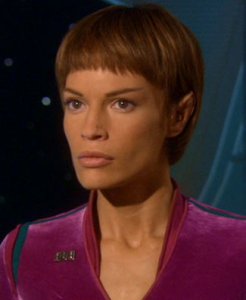
T'Pol is a fictional character in the Star Trek franchise. Portrayed by Jolene Blalock in the series Star Trek: Enterprise, she is a Vulcan who serves as the science officer aboard the starship Enterprise (NX-01).

Saavik is a fictional character in the Star Trek universe. She first appeared in the film Star Trek II: The Wrath of Khan (1982) played by Kirstie Alley. Robin Curtis took over the role for Star Trek III: The Search for Spock (1984) and Star Trek IV: The Voyage Home (1986).

"Amok Time" is the second season premiere episode of the American science fiction television series Star Trek. Written by science fiction author Theodore Sturgeon, scored by Gerald Fried, and directed by Joseph Pevney, it first aired on September 15, 1967.

"Unification" is a two-part episode of the syndicated American science fiction television series Star Trek: The Next Generation which features Leonard Nimoy as Spock. The first of the two episodes earned a 15.4 household Nielsen rating, drawing over 25 million viewers, making it one of the most watched episodes in all seven seasons of The Next Generation's run.
This article discusses the fictional timeline of the Star Trek franchise. The franchise is primarily set in the future, ranging from the mid-22nd century to the late 24th century, with the third season of Star Trek: Discovery jumping forward to the 32nd century. However the franchise has also outlined a fictional future history of Earth prior to this, and, primarily through time travel plots, explored both past and further-future settings.
"Kir'Shara" is the ninth episode of the fourth season of the American science fiction television series Star Trek: Enterprise. It was writer Michael Sussman's third episode of the season, while it was director David Livingston's second. The episode was the third in a three-part story arc, following on from the episodes "The Forge" and "Awakening". The title "Kir'Shara" refers to a Vulcan religious relic, and the three part Vulcan story arc explored themes relating to the Protestant Reformation resulting in comparisons to books such as The Da Vinci Code and The Celestine Prophecy, while the Kir'Shara itself was compared to the Nag Hammadi library.
"Awakening" is the eighth episode of the fourth season of the American science fiction television series Star Trek: Enterprise, and originally aired on November 26, 2004 on UPN. The script was written by André Bormanis and the episode was directed by Star Trek: Voyager alumna Roxann Dawson. The episode was the first of the season for both Bormanis and Dawson. The episode is the second of a three-part episode arc which started in "The Forge" and concludes in "Kir'Shara".
"The Forge" is the seventh episode of the fourth season of the American science-fiction television Star Trek: Enterprise, and originally aired on November 19, 2004, on UPN. Directed by Michael Grossman, the script was written by Judith and Garfield Reeves-Stevens, and formed the first part of a three-episode arc which continued in "Awakening" and concluded in "Kir'Shara".
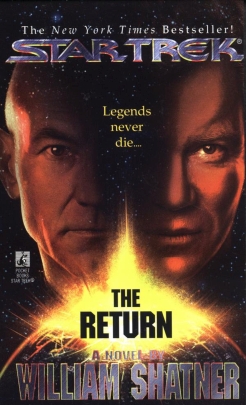
The Return is a novel by William Shatner that was co-written with Garfield Reeves-Stevens and Judith Reeves-Stevens. It is set in the Star Trek universe but, as part of the "Shatnerverse," does not follow the timeline established by other Star Trek novels. The book's sequel is Avenger.
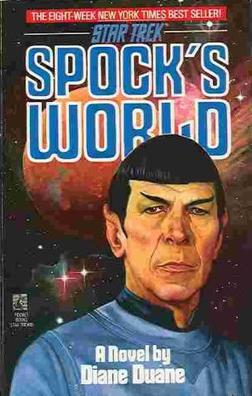
Spock's World is a 1988 science fiction novel by American writer Diane Duane, set in the fictional Star Trek universe. The plot revolves around a movement on the planet Vulcan to secede from the United Federation of Planets. The book alternates chapters that advance the main plotline with chapters that relate important scenes from Vulcan's history, and much of the book explores underlying themes in Vulcan philosophy and culture, especially the idea of cthia, a Vulcan philosophical concept translated in the book as "reality-truth — seeing things the way they really are, instead of the way we would like to see them".
"Fusion" is the seventeenth episode of the television series Star Trek: Enterprise. Set in the 22nd century, the science fiction television episode is about a spaceship exploring a galaxy filled with alien life. It aired on UPN on February 27, 2002.
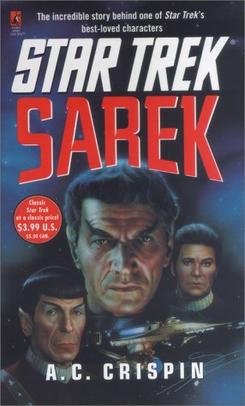
Star Trek: Sarek is a novel by A. C. Crispin, set in the fictional Star Trek universe. It is set shortly after the motion picture Star Trek VI: The Undiscovered Country. Ambassador Sarek of Vulcan discovers evidence of a complicated plot to cripple the United Federation of Planets; he must work to find out who is behind it while also coming to terms with the death of his human wife, Amanda Grayson. A secondary storyline follows the adventures of Peter Kirk, nephew of James T. Kirk, who inadvertently becomes caught up in the enemy's schemes.

Star Trek: Countdown is a four-issue comic book prequel to the 2009 film Star Trek by IDW Publishing. It follows the characters of Spock and the Romulan Nero during the year 2387, detailing the events that cause them to travel to the 23rd century. The story serves as both a lead up to the film, and as a continuation of the Star Trek: The Next Generation franchise.
The following outline is provided as an overview of and topical guide to Star Trek:













